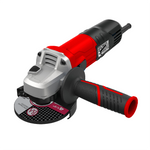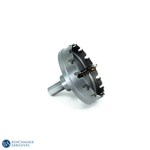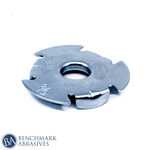
11 Effective Ways To Cut Sheet Metal With Power Tools

Let's take a look at the best ways to use tools to cut sheet metal.
11 Ways To Cut Steel With Power Tools
1. Using An Angle Grinder
It is among the most obvious options when it comes to cutting metal, whether as a professional or a DIYer. As a result, these handheld power tools are both easy to use correctly and reasonably priced for a layperson to buy.
Once in place, an angle grinder's small, quick, circular blade can easily cut through the thinnest stock and even some thicker stock (including bolts) without any pushback. Angle grinder kickback is typically used for this purpose. For this reason, mounting your unit with a side support handle is crucial. Even if the blade buckles slightly during the cut, you can guarantee that your cuts will stay smooth.
Angle grinders are also known for their general adaptability. After all, most devices work with a range of blade sizes. If your line of work requires you to work with various materials throughout a project, you'll probably be able to use your electric angle grinder for more than just cutting metal.
2. Using A Nibbler
The nibbler was probably the only power tool that served as a straightforward improvement for a common metal-cutting hand tool. Unfortunately, many non-professionals are unfamiliar with the nibbler, given its ability to produce deep cuts in thin-gauge steel. In that role, this small, pistol-shaped power tool can cut cleanly and quickly without creating a lot of noise or distortion in the metal object it is intended to work on. The nibbler's actual purpose is simple when it comes down to it.
A nibbler punches out a line of metal that runs beneath its head as it moves. As a result, using a nibbler frequently will leave your desk covered in curly metal filings. These filings should be cleaned up as soon as possible because their small size might result in unpleasant cuts if they accidentally brush across exposed skin.
Be sure to assess the maximum thickness of steel you or your team routinely cuts before investing in a nibbler. This is due to the wide range of sizes (and costs) available for nibblers, which can cut up to 14-gauge steel.
3. Using Miter Saw
If you are familiar with miter saws, you know that they perform comparable tasks to circular saws. But because of their special arm-based mounting design, they may work at an angle without the operator having to support the machine's weight. When it comes to cutting through metals, a lot of miter saws can perform similarly. However, you will still want a blade made to cut non-ferrous metal, so research your tool's capabilities before using it for a steel-processing project.
When using a miter saw to cut metal, there are several things to consider. First, these units have the strength to bend thinner stock while cutting due to their strength. To avoid warping, you should utilize wood backing whenever possible. Additionally, keep in mind that while miter saws are in use, a lot of waste is often released. Wearing the right safety gear is essential when using a miter saw to cut through metal to avoid accidents.
4. Using A Circular Saw
Long-term construction workers know the many other uses of circular saws besides cutting through wood. If you have the right disc blade, you can use these saws to cut through sheet metal very frequently. In particular, it is often necessary to use a blade that is extremely abrasive and capable of cutting through the material with the least resistance. Carbide-tipped blades are typically the right choice for this application. You'll be astonished at what types of metals a circular saw can slice through with the right blade set in your tool.
Even though certain circular saws do support a metal-cutting blade, not all of them can work with metal. Always read the user manual for your tool before beginning any metal-cutting projects with a circular saw that you own.
5. Using An Oscillating Saw
With most conventional metal-cutting power tools, making flush cuts through metal fixtures (such as plumbing) might be challenging. For that reason, you should get an oscillating saw with a metal-cutting blade attachment. Because of their horizontal design, these tools can gradually and steadily cut into metal fittings. As a result, this strength usually has little chance against bolts and nails.
But remember that this power tool wasn't designed to make clean cuts through metal stock. While this tool can complete the task, you'll probably need to clamp the workpiece to prevent movement from the tool. A saw can also be viable if you work on a demolition site where this equipment is already common.
6. Using A Bandsaw
Last, you'll be surprised to learn that some band saws can cut through metal. Similar to previous saws in this collection, specialty blades enable this saw to work with metal. Bi-metal blades are often used in this situation, although carbon steel blades are also sometimes successful. This tool can occasionally be used to cut thicker stock.
Professionals often avoid this tactic because it moves quite slowly, especially when cutting thick metal stock. Due to a bandsaw blade's thickness, this technique also rapidly depletes blades. If this technique is applied frequently, the cost can rise quickly.
7. Using A Reciprocating Saw
This is one of the most affordable and adaptable solutions for metal-cutting power tools that a DIYer would want to think about. That's because the kinds of metal stock and things that DIYers are likely to encounter may easily be cut through with a reciprocating saw.
To accomplish this, reciprocating saws are frequently used to remove old nails and cut through thin timber. A carbide tip blade is necessary for this, and most of them come with one.
The use of reciprocating saws in demolition may already be familiar to you. As a result, it shouldn't be surprising that this instrument produces rough metal cuts. As a result, precision metal cutting should not be performed with it.
8. Jigsaw Tool
A Jigsaw is nowadays a forgotten tool for cutting metal. However, it is excellent for cutting pipes, metal sheets, and other materials. An essential tool for many metalworking operations, a jigsaw with the correct blade can produce precise, clean cuts.
9. Plasma Cutter
One of the most often used cutting methods is plasma cutting, which involves meeting electrically conductive material with a high-velocity stream of ionized gas, or plasma. Nonetheless, it is frequently utilized in industries and works best with larger sheets.
Electricity initially ionizes the gas in plasma cutting, creating a plasma that is then guided via a nozzle. The metal is vaporized and ejected by the extremely localized heat generated by the jet's average power, producing a very smooth cut.
10. Laser Cutter
Laser cutting uses a concentrated high-power density laser beam to cut the workpiece. It is a thermal cutting technique that generates thermal stress and affects sheet metal processing in numerous ways. This technique works well for intricate shapes and designs where accuracy and polished edges are essential.
When a laser cutter directs a narrow stream of light onto the metal surface, the material is sliced by melting and burning. Additionally, it can be individually programmed and mechanized for various designs that apply to this process when needed.
11. Waterjet Cutting
Waterjet cutting is a new and aggressive process that uses water jets to cut sheet metal and other materials, and sometimes garnets as well. It is highly valued for its versatility and ability to preserve the material's qualities.
It uses a pump to apply pressure of up to 90,000 psi, which guides water toward the location of a tiny hole. To improve the stream's cutting force and precision, garnet is added to certain materials with hard surfaces.
CONCLUSION
In this article, you have seen many ways to cut sheet metal. Your options for cutting up metal workpieces are quite varied, whether you have access to powerful power tools or merely have access to hand tools. Decide which of the possibilities above best fits your skill set. Then, you can invest in the tools you need to accomplish your metal-cutting tasks efficiently and accurately.



































































